The Best Guide to Facebook Retargeting Ads You'll Ever Find
Posted on 11/2/2023
Reviewed by Arnt Eriksen updated at 11/25/2023
Introduction
Facebook Retargeting Ads is one important part of building customer relationships in a profitable way.
Statistics have it that about 52% of people in America believe in love at first sight, and only four in ten people have experienced it. I could bet that the figures would be way lower if they came from other continents.
If it's this unusual to find love at first sight, how strange would it be to expect customers to buy from you the first time they come into your store?
Most customers will not buy from you until they have had three to four encounters with your brand. It would be weird to wait around for your first-timers to fall in love with your brand. What is more strategic is putting deliberate measures in place to "seduce" your customers.
On Facebook, this involves using retargeting ads. In this article, we'll take you through the nitty-gritty of remarketing.

What is Facebook Retargeting?
Let's start by breaking down the terms.
Ad retargeting refers to a marketing strategy that focuses on reaching people who have already interacted with your brand in one way or another.
Facebook Retargeting helps you locate people who have interacted with your brand and trace their Facebook profiles based on the available data. Once tracked, you can guide them back to your website using Facebook ad campaigns. These Facebook ads are designed specifically to reroute these visitors back to your page to take a specific action like buying your product, installing an app, or signing up for a consultation.
Facebook retargeting strategies are not necessarily targeted at only those who have visited your website for the first time. You can also run Facebook retargeting campaigns based on these sources:

App Activity
People who have installed your software or carried out certain activities on your app can also be retargeted on Facebook
Offline activity
You can take it off the internet by retargeting people who have attended an event hosted by your brand, or made phone calls to make inquiries.
Engagement
Maybe they've not followed your page or visited your website, but they've liked your post on Instagram, watched your video ad on Facebook, left a comment under your blog post or retweeted your post on Twitter. You can retarget all those people with your ads.
How Does Facebook Retargeting Work
All retargeting campaigns on Facebook are displayed to your target audience across the Meta audience network. This includes Facebook and Instagram.
Now let's use Udemy as a case study:
A number of people visit the Udemy website to check for a photography course. They scan through the website and move to other websites without signing up on Udemy.
Facebook's algorithm tracks the data of this website's visitors and finds their Facebook accounts.
The algorithm determines if these website visitors match the target audience for the retargeting campaign.
The algorithm shows the retargeting ad to any of them who match the audience.
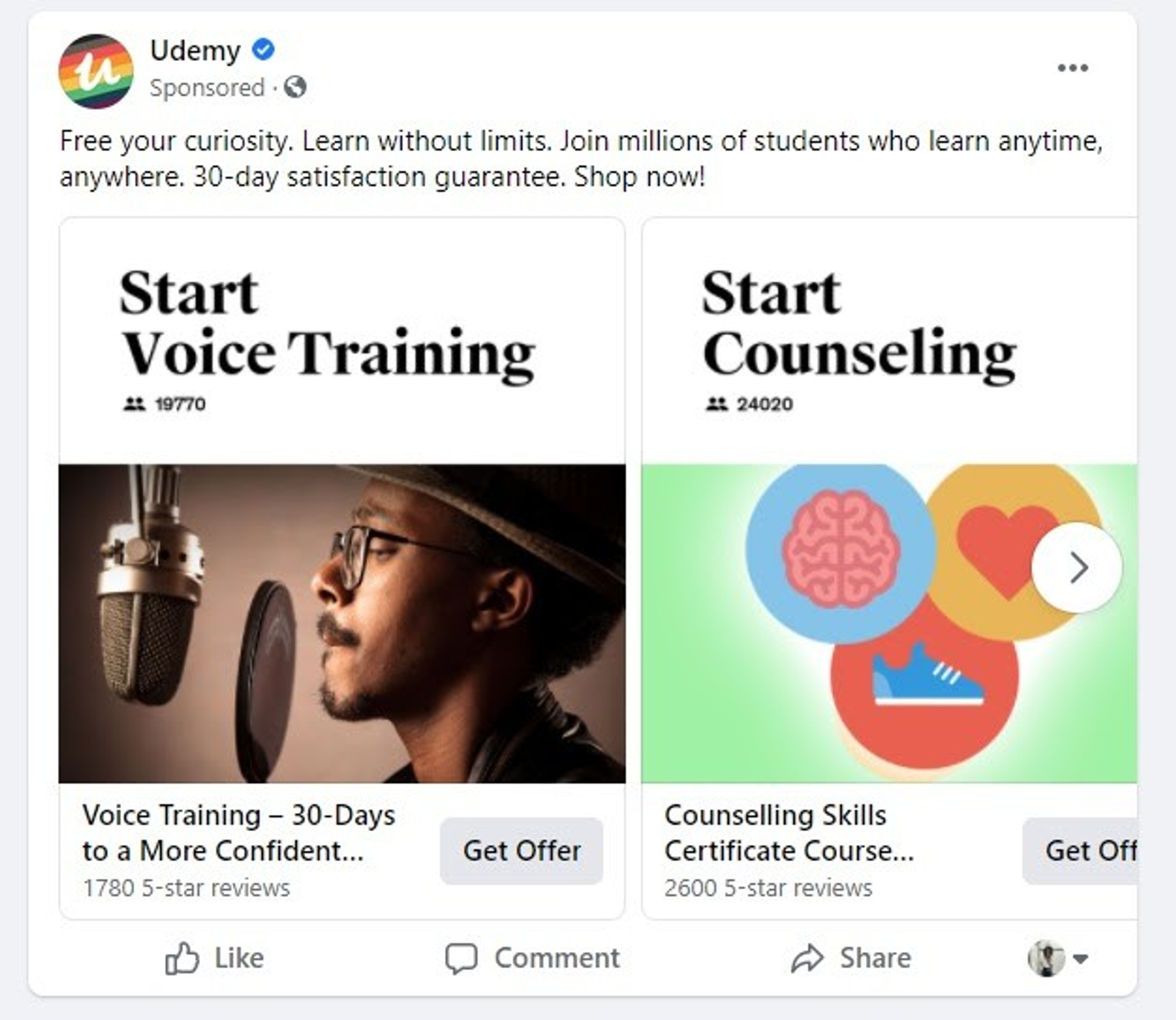
Forms of Facebook Retargeting
As simple as this progression is, you could employ two mechanisms.
List-Based reTargeting
List-based retargeting is a manual method of creating a retargeting audience. With list-based retargeting, you have to upload the list of email addresses you would like to retarget to your Facebook ads manager. Needless to say, this is not the most effective method, mostly because it consumes a lot of time and energy. Plus, it can be easier to miss. There's a chance that people do not use the same emails to sign up on Facebook. In this case, you won't be able to retarget them.
As such, list-based retargeting is more effective for small lists of people whose details have been verified. In case you have a larger audience whose details are yet to be verified, pixel-based retargeting has to be the best bet.
Pixel Based Retargeting
Pixel-based retargeting is a more automated method that reaches customers based on the activities they have performed on your app.
If Facebook Pixel functioned in a real-time store, this is what it would look like.
You step into a beauty store to purchase some cosmetics. Just as you take the products to the counter, your investor calls for a business meeting so you leave the products and hurry out.
Unknown to you, a camera has recorded all your activities within the store and sent it to Facebook.
The weekend flows into a busy week and you still have not found time to go back for the products. Coincidentally, you stumble into Facebook ads from the store and pictures of the eyeliner you picked on their Instagram page.
If you've had such experiences with online stores and they got you thinking that you were destined to buy that product, then let me show you what destiny looks like on the backend.
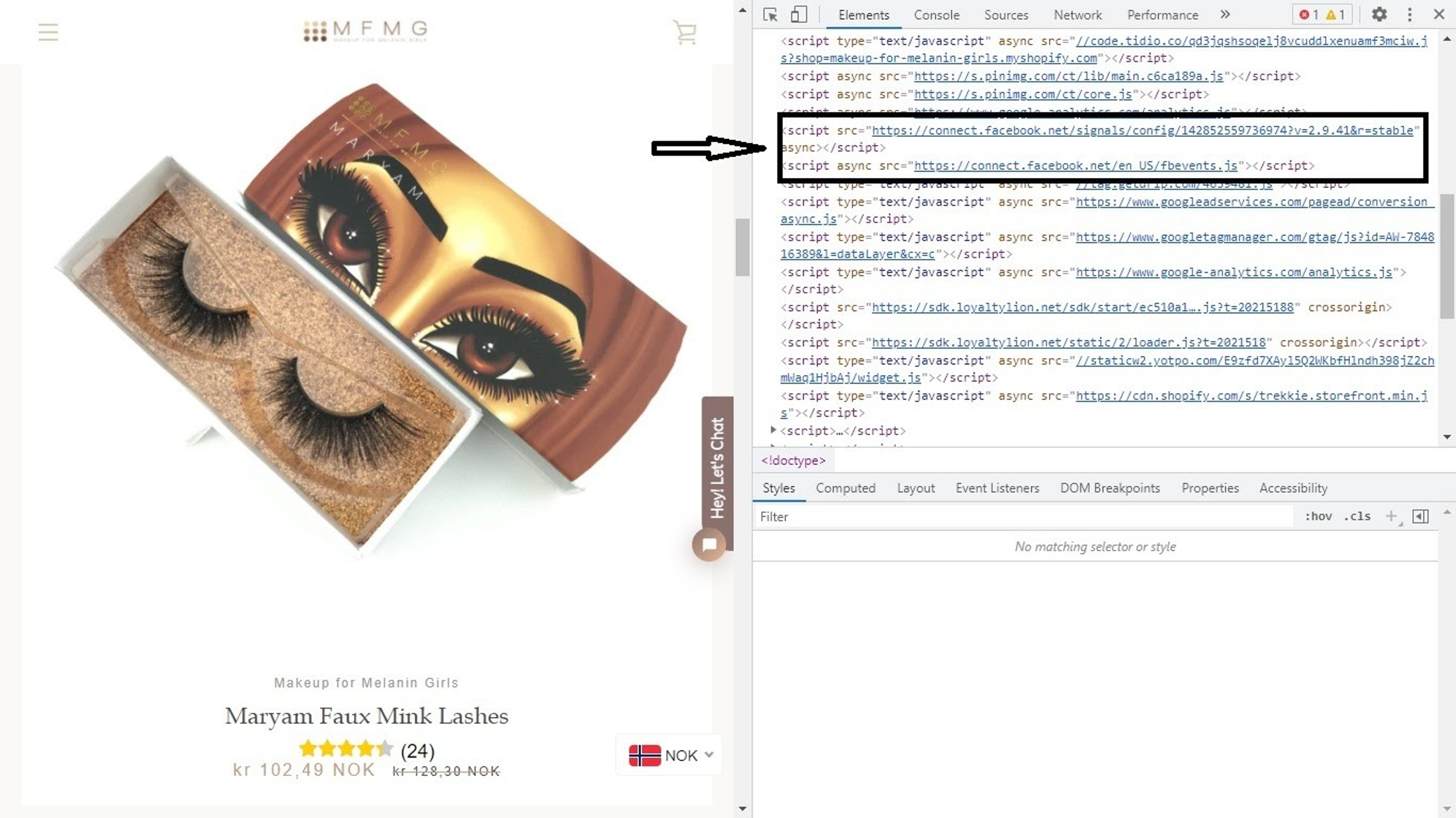
Facebook pixel is a Javascript code that you connect to the backend of the website with the sole aim of tracking the activities of your website visitors.
Beyond tracking, it is an analytic instrument that gives Facebook a report of data on your website so Facebook can use it for retargeting campaigns.
When your Facebook pixel is all set up in your Facebook Ads manager, simply copy the code and paste it into your website's code when you have access to it.
Let's make it a bit more practical so you understand it when setting up your retargeting ads.
Facebook Pixels target certain actions on your page. In technical terms, they are called "Events." Whenever anyone takes this action on your site, Facebook pixel records the data and reports it to your Facebook Add manager. In most cases, Facebook Pixel can monitor "Events" like:
- Making a search
- Viewing your content
- Filling out a form
- Completing your registration
- Adding product to a wish list
- Adding product to a cart
- Adding payment info
- Making a purchase
What is Facebook retargeting pixel used for?
On the surface level, Facebook Pixel is useful for Facebook ad retargeting, but there is also a way to work around it so it goes beyond being just a retargeting strategy. Let's look at some uses for the Facebook Pixel.
Retargeting Audiences:
Building a custom audience requires certain details. You may have to add a specific location, gender, age, population size, or preferences. But with Facebook Pixel, you can automatically create a custom audience for your retargeting campaign. You may decide to narrow it down to those who have performed a specific action or visited a specific page.
This is a more effective way of creating audiences because you don't have to make a random selection using filters and hoping that you reach the right audience.
Cloning your Audience
People who have visited your website tend to have some things in common. Naturally, people who also have these traits but have never visited your website may be interested as well. As such, Facebook Pixel can create a new custom audience by filtering people who share similar characteristics with your website visitors. This makes your targeting more effective and gives you higher chances of reaching the right kind of people when you reach out to cold leads.
Before you get this done, you need to create a "lookalike audience."
The look-alike audience is simply a model audience that Facebook Pixel can build the clone after.
Suppose, you have marketed a new app that converts web content to various languages. You noticed that those who have indicated an interest in downloading the app are either copywriters or web developers, and all of them live in Asia.
Facebook Pixel reports this data to Facebook, which uses it as the model audience. It then creates an audience out of people who have the same characteristics but have never visited your page or installed your app. This initial audience that has displayed interest is your model audience, used to identify the new people who make up the cloned audience - the lookalike audience.
You can run entirely different Facebook ads for these people knowing that they have a high chance of being converted.
Tracking and Improving Conversion
Think of it as a journey. If you don't know where you are at present, you can hardly know where you're going to.
Facebook Pixel can help you track the stages of conversion progress on your website. With Facebook Pixel, you can analyze the conversion data on your website. You can determine what level of the sales funnel most of your website visitors are at and how best to convert them.
This is spectacular because you would normally need an analytical tool to monitor the performance of your campaign, but with Facebook Pixel, you have a ready-made report.
To get it all running, you need to get your Facebook Pixel installed on whatever page will serve as your conversion page.
For instance, you can attach your sign-up form to your Facebook ad and attach a thank you page to your sign-up form. If you really want to track how many leads you have converted, you don't attach your Facebook pixel to the sign-up page. This is because the pixel will record everyone who lands on the sign-up form, even if they don't complete the form.
When you put the Facebook Pixel on the thank you page, it will only record those who completed the form and progressed to the thank you page. This helps you determine how well your campaign is doing and what your return on investment is in real-time.
This helps you to find out how well you are doing and to identify the best strategies to employ.
Creating Dynamic Retargeted Ads
Advertising can be rigorous when you are marketing one product. It gets even more complicated when you have to run multiple ads for various products. This could also mean that you have to create different audiences.
Facebook pixel can make this work easier by creating a centralized hub for sorting out each product's advertisement. With this functionality, you can create dynamic ads for various products. You can also continue to control these ads on the fly.
In real-time, dynamic ads could appear as suggestions of products you may want to get. More often than not, you have viewed related items on an advertiser's website.
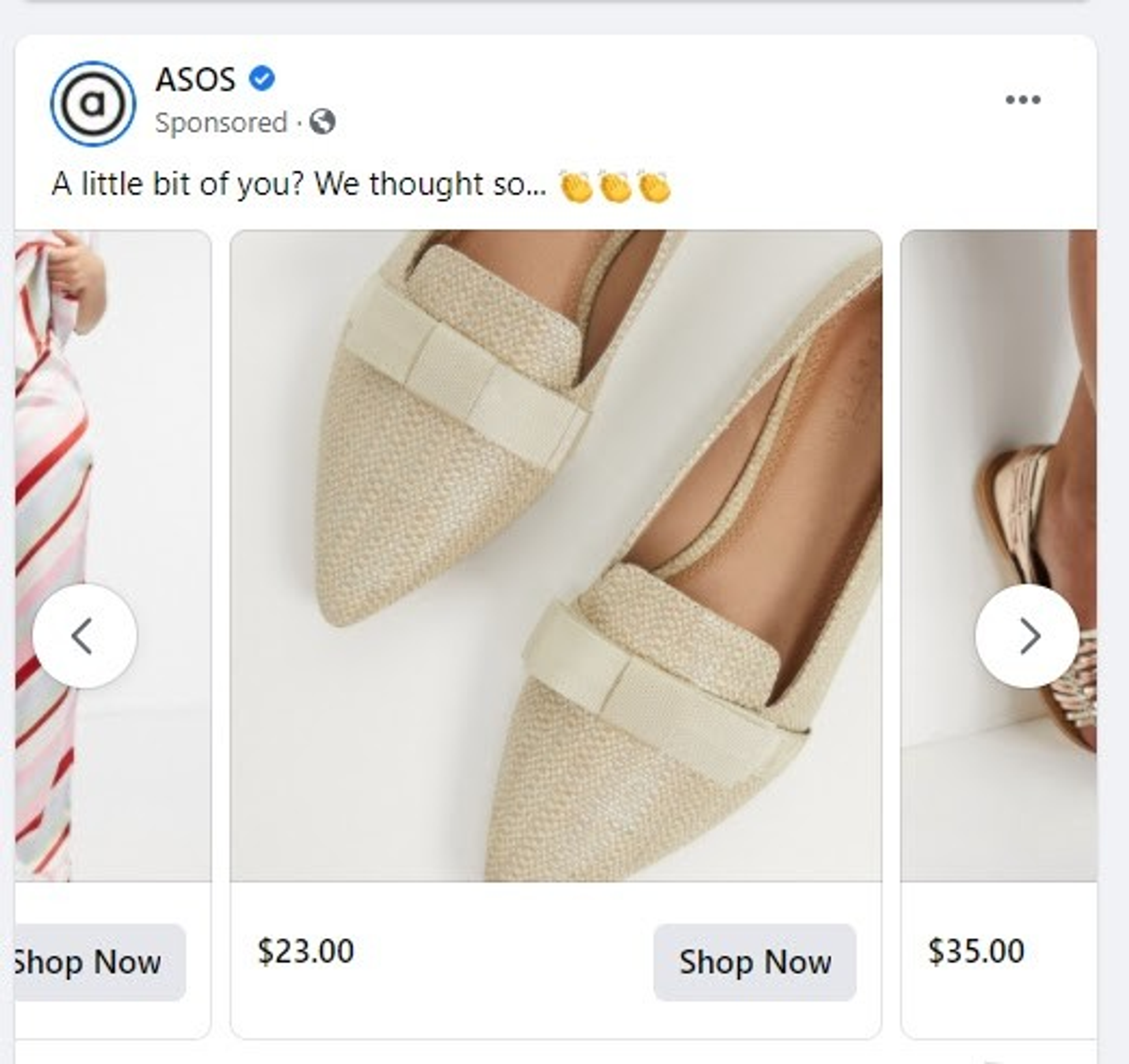
In the same way I got ads for items related to the search I had made, every other person who has visited that website will get suggestions that are related to their unique searches.
Does this mean that the site owners can predict what I would come for before visiting their website, or do they quickly create retargeted ads right after I leave?
They simply attached Facebook pixel to the backend of their website to automatically produce dynamic retargeting ads. On the back end, such ads would look like this:

Dynamic retargeted ads help you show customers products that are relevant to them based on their likes, preferences, intents, and actions while on your website.
Instead of going through the routine of creating one ad per product, simply upload a catalog of your items (a product feed) and create one continuous retargeting campaign that covers everything in your catalog. This is very similar to the way Google's Shopping Ads work, so if you are familiar with those you'll feel right at home. When a customer interacts with your page and shows interest in a product, Pixel notifies Facebook which automatically pulls up a relevant ad and shows it to the customer when next they visit your website.
A dynamic retargeting ad would not be effective without a product catalog. But if you run your store on Shopify or any other e-commerce platform that partners with Meta, exporting a product feed should be an easy matter.
Woocommerce, Shopify, Big Commerce, and Ced Commerce are some of Facebook's e-commerce partners.
With Facebook pixel attached to your website, you can automatically create dynamic retargeting ads.
Benefits of retargeting
Let's start with statistics.
For starters, you should use Facebook retargeting because you're not the only one who sees it as a great marketing platform. In fact, 65% of marketers have a budget allocated specifically for Facebook retargeting campaigns. Marketers also find Facebook retargeting campaigns a preferable strategy since 67% of them use Facebook retargeting campaigns. This allegiance to Facebook retargeting is easy to understand seeing that it records a 1,046% rate of efficiency compared to all other ad placements.
Facebook targeting gets the job done to a significant extent, seeing that at least 37% of customers click on a retargeted ad.
Now that the statistics have caught your attention, let's wrap it around bullet points.
It’s the highest ROI advertising activity:
If you already have experience with Facebook advertising, you should know that Facebook runs various forms of ads. Of all of these forms of advertising, Facebook retargeting gives the highest return on investment. Now, this is not to say that other forms of advertising do not pay off. Different kinds of advertising come with various objectives. For instance, your Facebook ad can target people who have never heard of your business, but it takes time for ad campaigns like this to pay off.
Target customer behavior
When you offer various products, you can't really tell what your new visitors would want. But using Facebook retargeting can help you distill the specific behavior of each customer and automatically show them ads that relate to them based on their activity on your site.
For instance, this furniture company sells various things including rugs, cabinets, couches, drawers, and bed frames.

For the store to know what product each website visitor is interested in, it must know what pages or products the visitor has viewed.
With this information, the store can show retargeting ads that show customers only products that are relevant to their interests.
Increase conversion
The average conversion rate of e-commerce stores has not moved beyond 1.62%. However, Facebook remarketing ads give you a chance at rising above this number.
It is a known fact that only a few customers would love your brand enough to buy at first sight. Facebook retargeting helps you ensure that they fall in love at the second, third, or fourth contact.
It goes beyond reaching them more than once. With retargeting, you can establish a deeper connection between you and your customers.
When you plan for an ad to retarget those who have abandoned their shopping cart or failed to check out, its message would be different from those who have only bounced from your landing page.
Wherever they are on the sales funnel, you can convert them to sales using Facebook retargeting ads.
Guidelines to set up Facebook Retargeting Ad Campaign
Setting up a Facebook retargeting ad campaign is pretty easy when you get the procedure right. To set up your Facebook retargeting ad campaign, follow the steps below.
The Facebook Retargeting Pixel
Create a Pixel
This is one of the most important parts of all Facebook ad campaigns. Seeing that it's the bridge that links your website to your Facebook ad campaign, you want to pay attention to all the necessary steps.
Start by signing in to your Facebook account and clicking "Ads Manager" on the toolbar by the left.
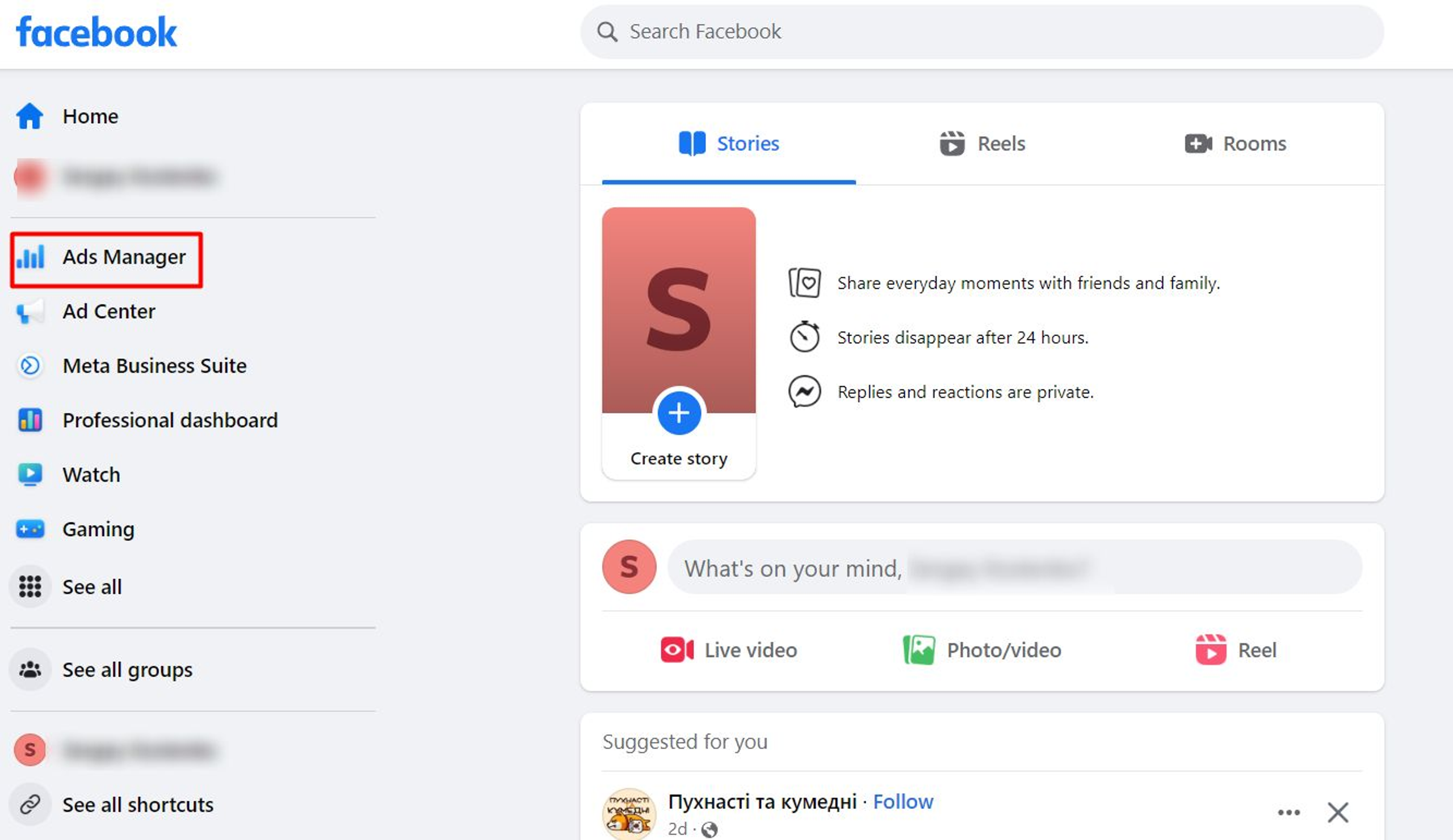
On the next page, find the All tools menu and click it to open the dropdown menu. In that menu, click "events manager".
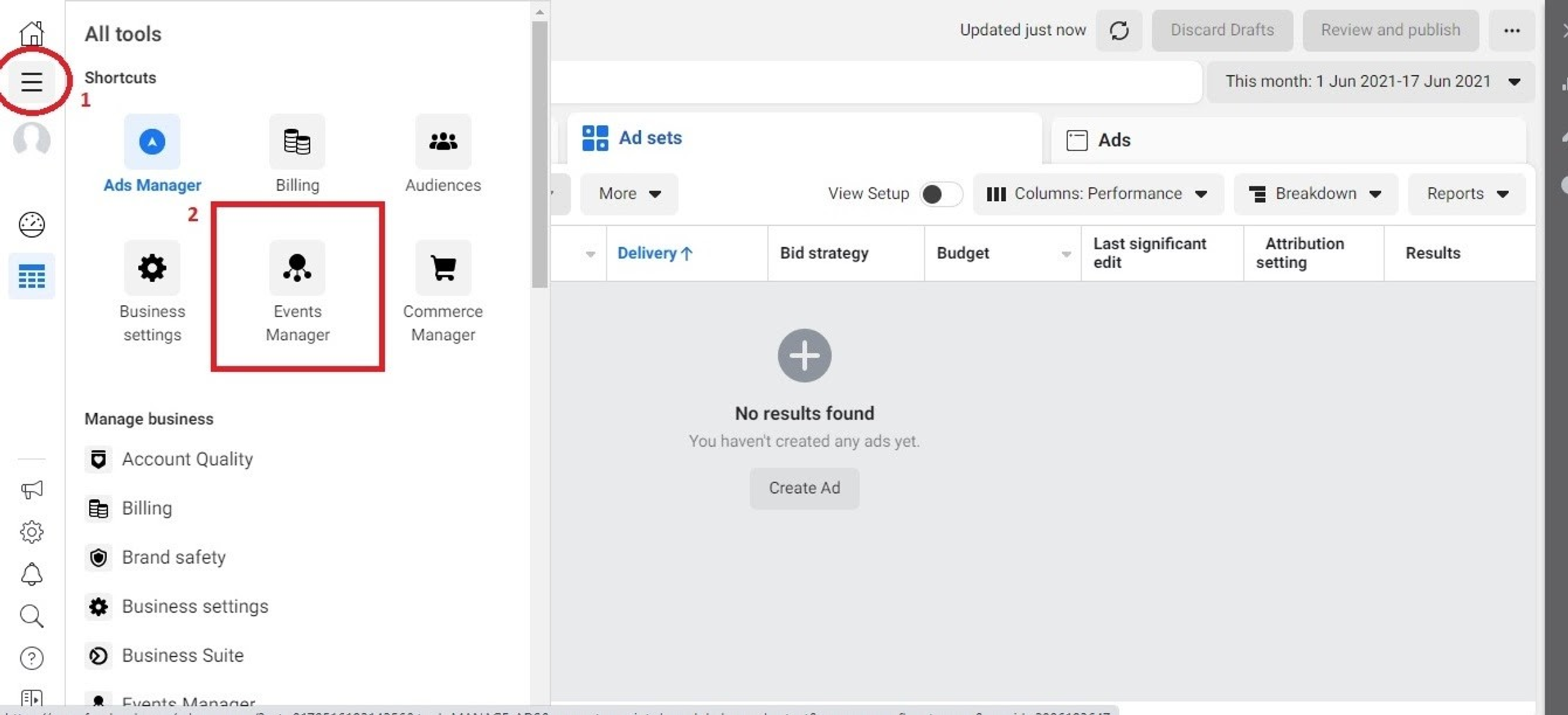
On the next page, click Connect A Data Source.
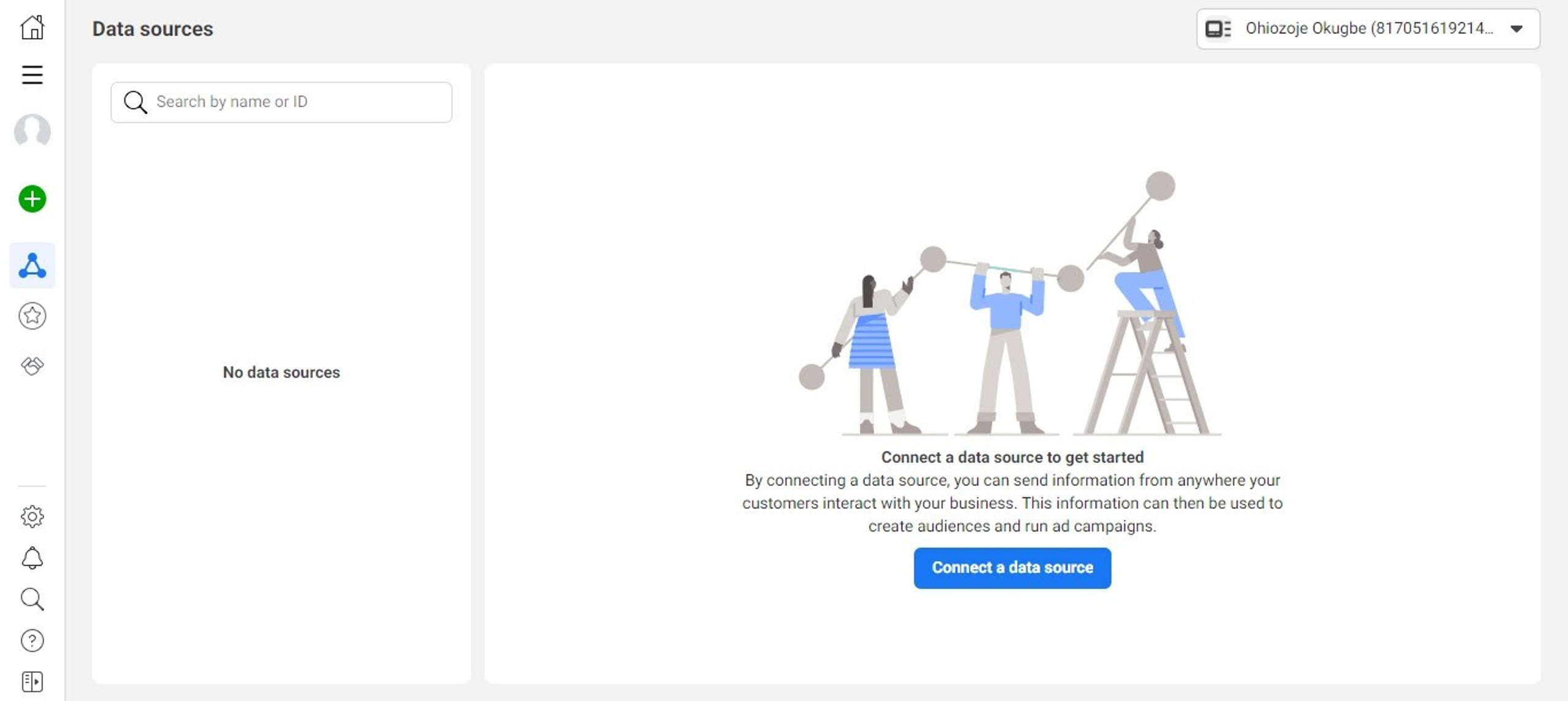
On the next page select web as your data Source option. This is because you're monitoring the actions of your website visitors.

Another table of options pops up and you click "Facebook Pixel", then "Connect"
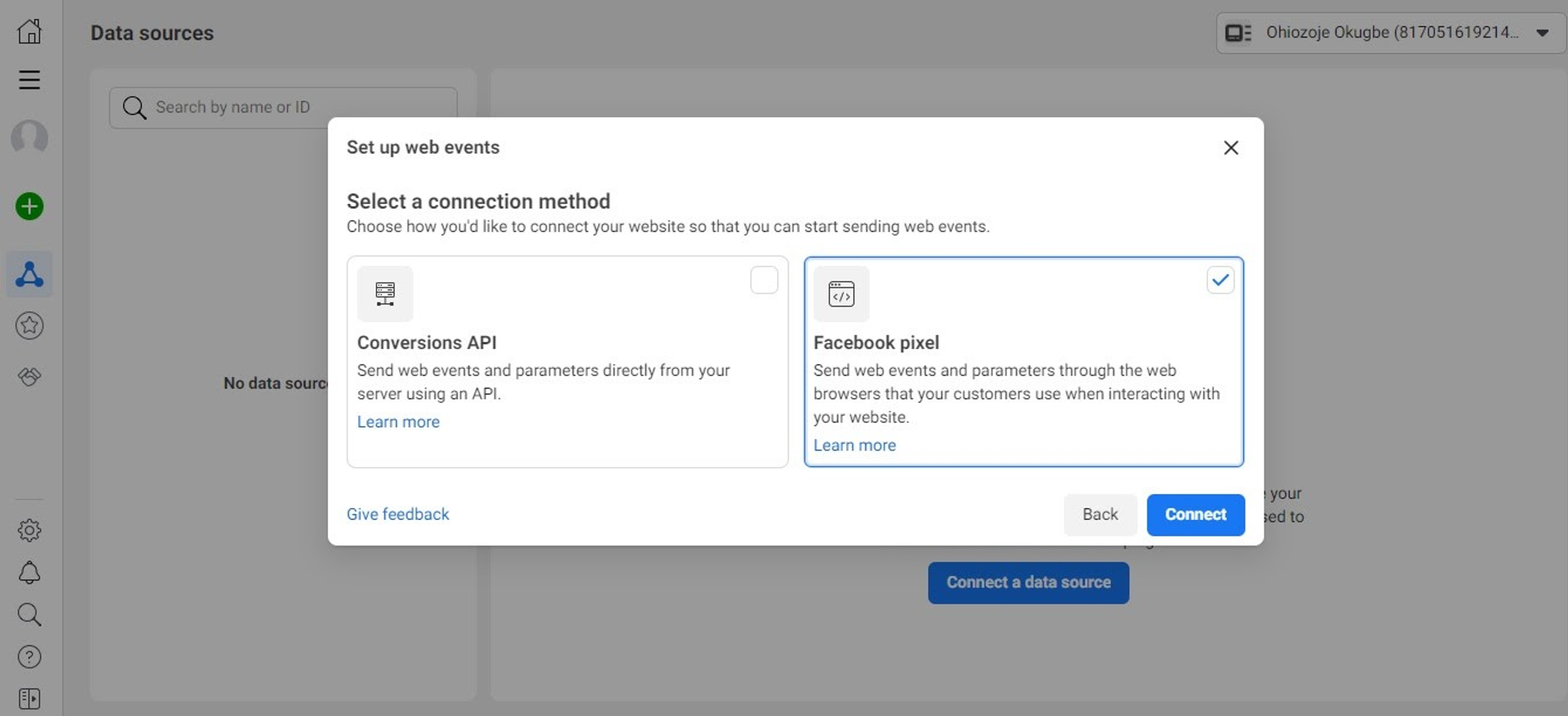
The next page brings you to a page where you are given general information about the Pixel. Click "Continue."
A window pops up where you enter the name of your pixel and your website URL.
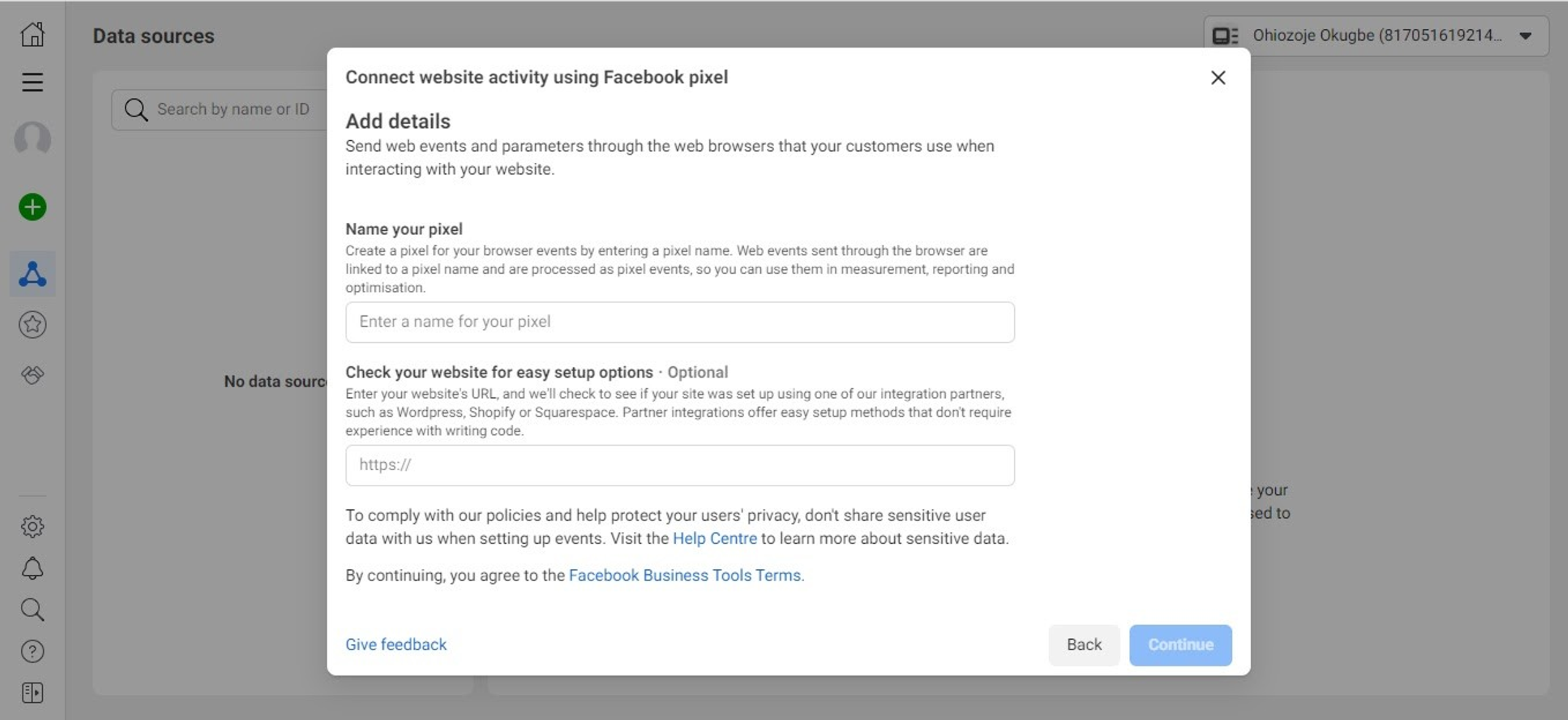
Once this is done, you have completed the creation of the pixel.
Installing the Pixel
You have two main methods of installing the pixel: manually or through partner integration. The manual method is more versatile, while partner integration involves synchronizing your pixel with a website built on a CMS platform that has partnered with Facebook. If you choose to go manual, Facebook gives you the option to email the instructions to a third party, like your web developer.
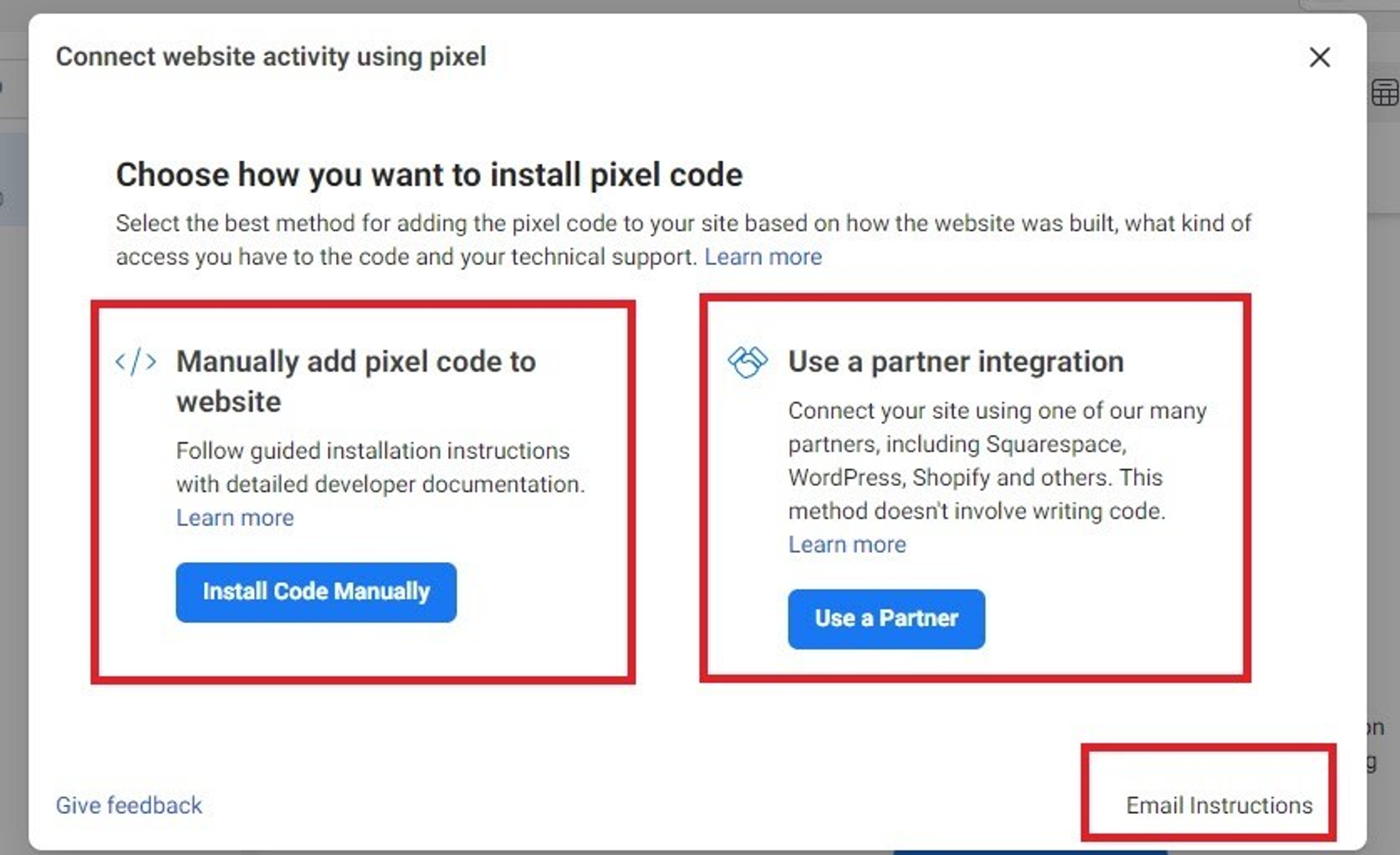
If you plan to add the Pixel manually, choose the option from this page and the URL is automatically copied to your clipboard.
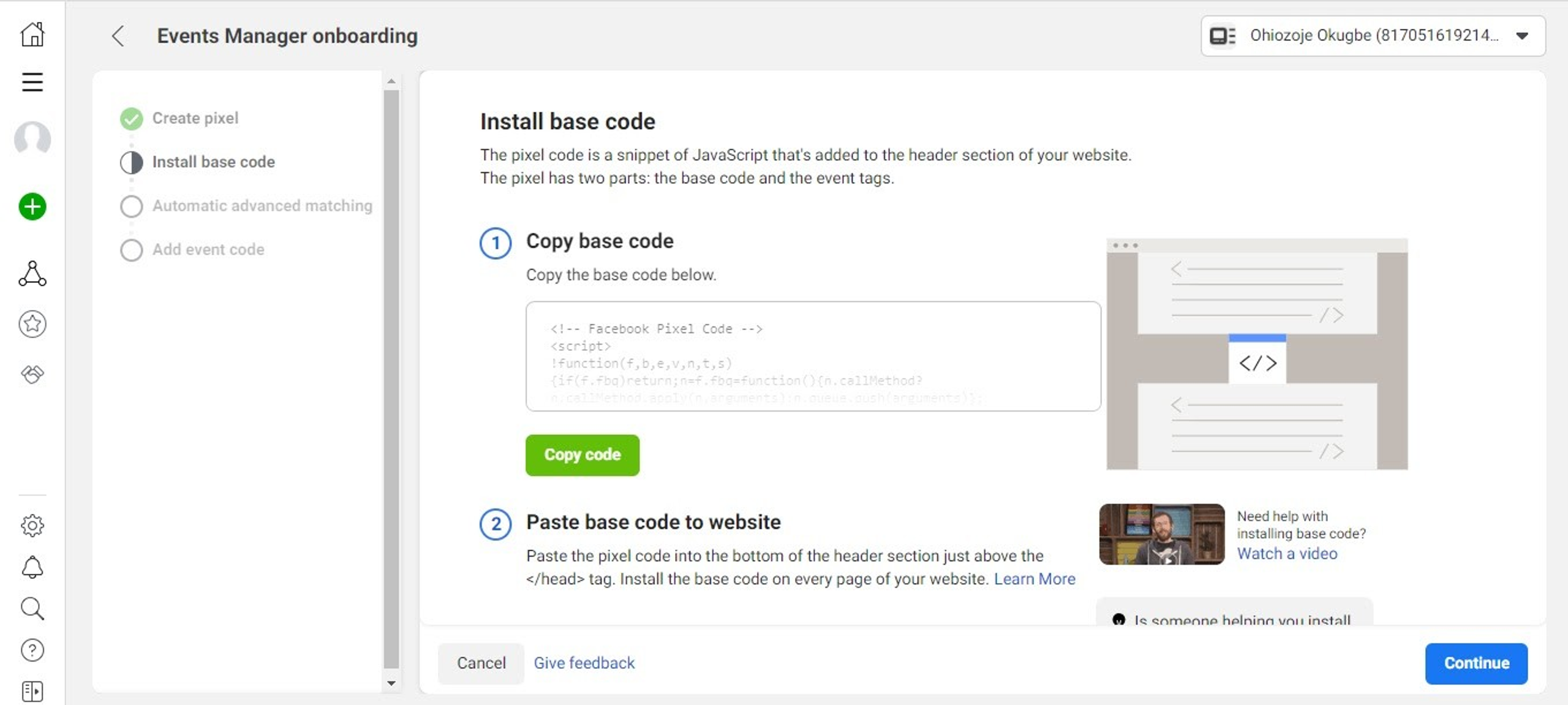
Go back to your website and paste the code in the header template.
If you run a WordPress site, then the "Install Header and Footer Plug-in" makes it a bit easier to paste the code.
When you are done, go back to your website and click "Continue." This takes you to a page where you can get all the matching done. This page would typically look like this.
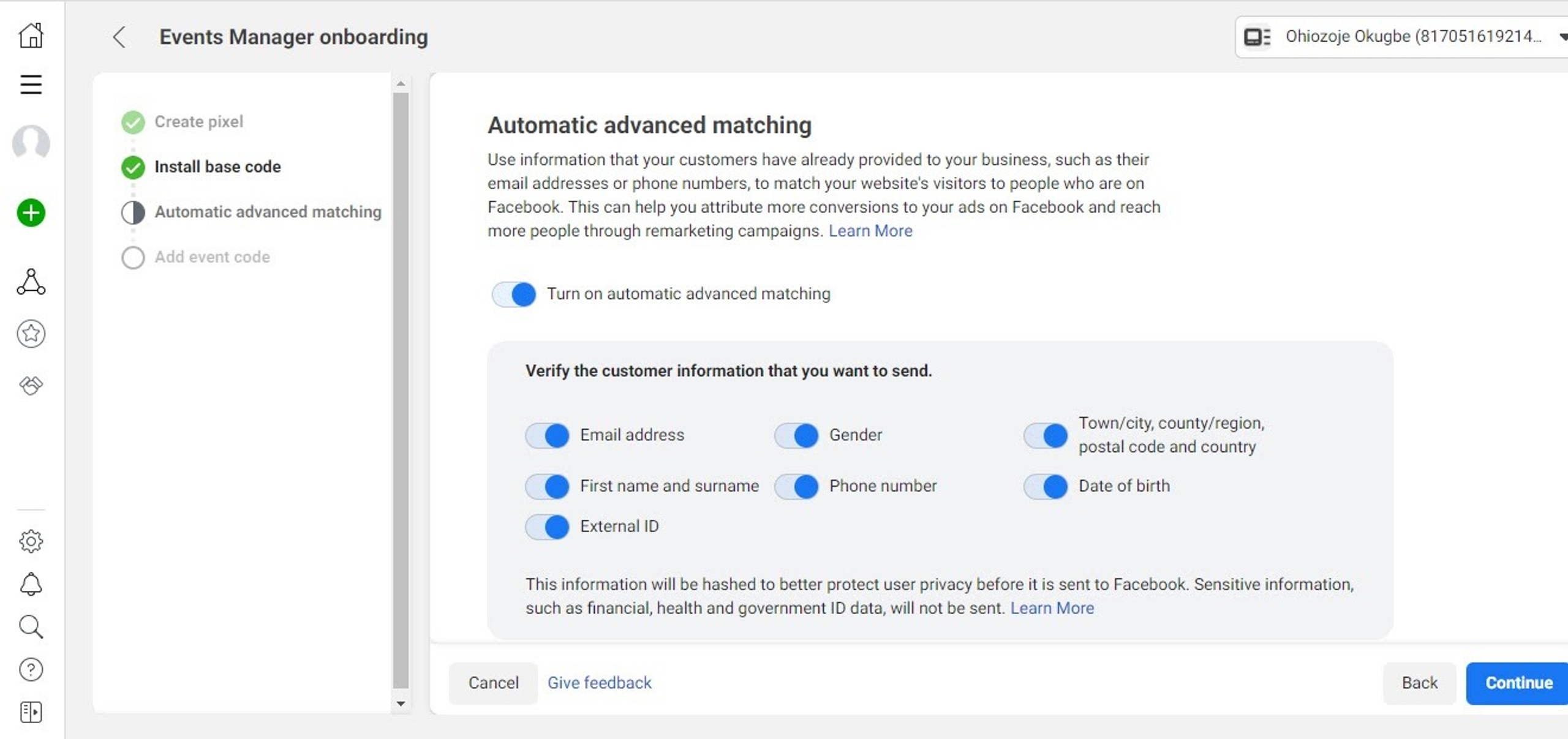
The next step is to install the codes for the events you have chosen to track.
If you are installing your pixel using partner integration then you need to pick which CMS platforms you are integrating with.
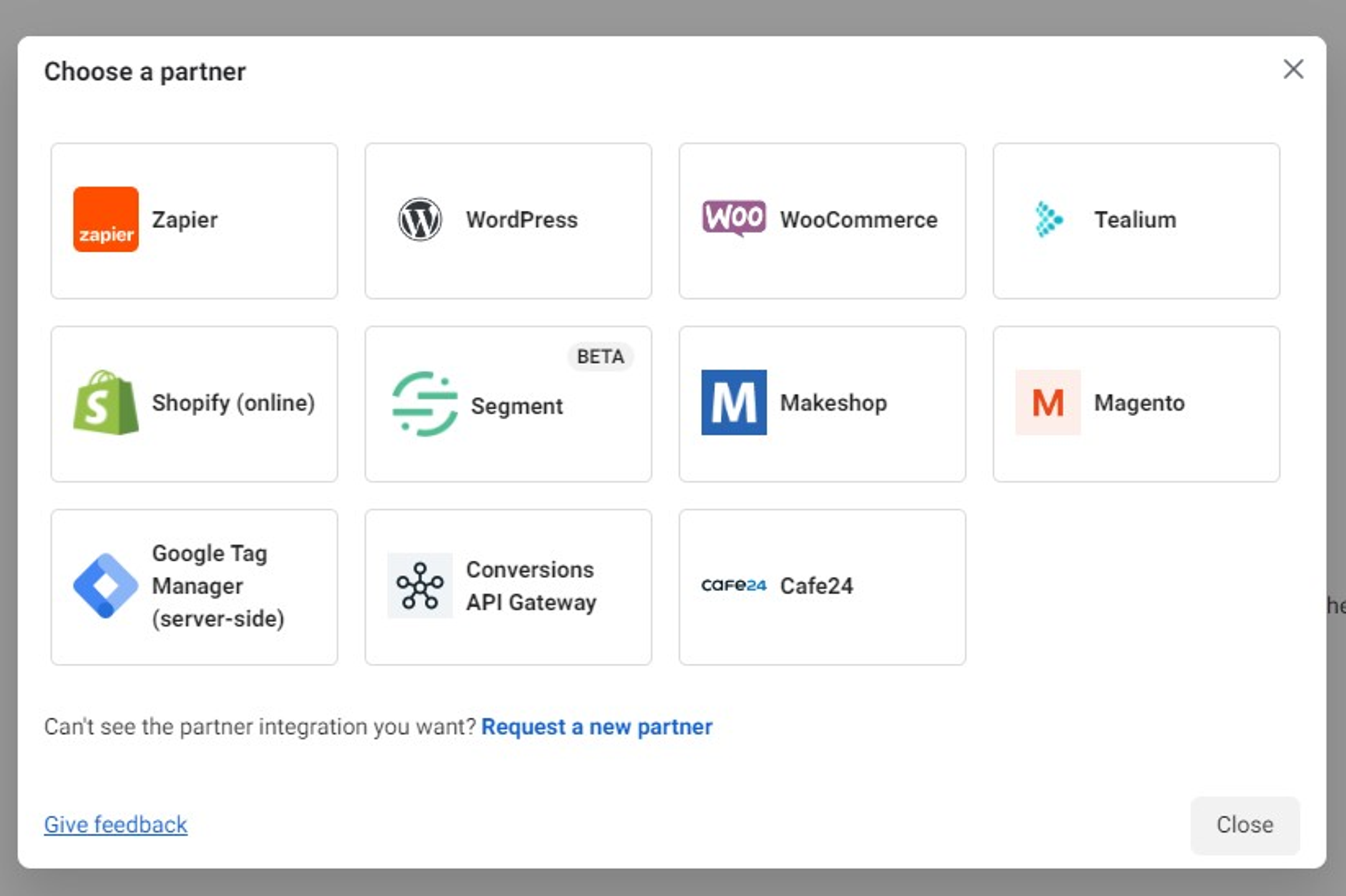
Even if you have installed your Pixel with the Partner integration system, you can match your events by clicking on the appropriate options.
Then click on see instructions and obey the next set of prompts that follow. It is important to note that the instructions differ based on the partner platform.
When you are done with the integration process, come back to the page below and click the box as a completion of the setup. Hit the Next button.
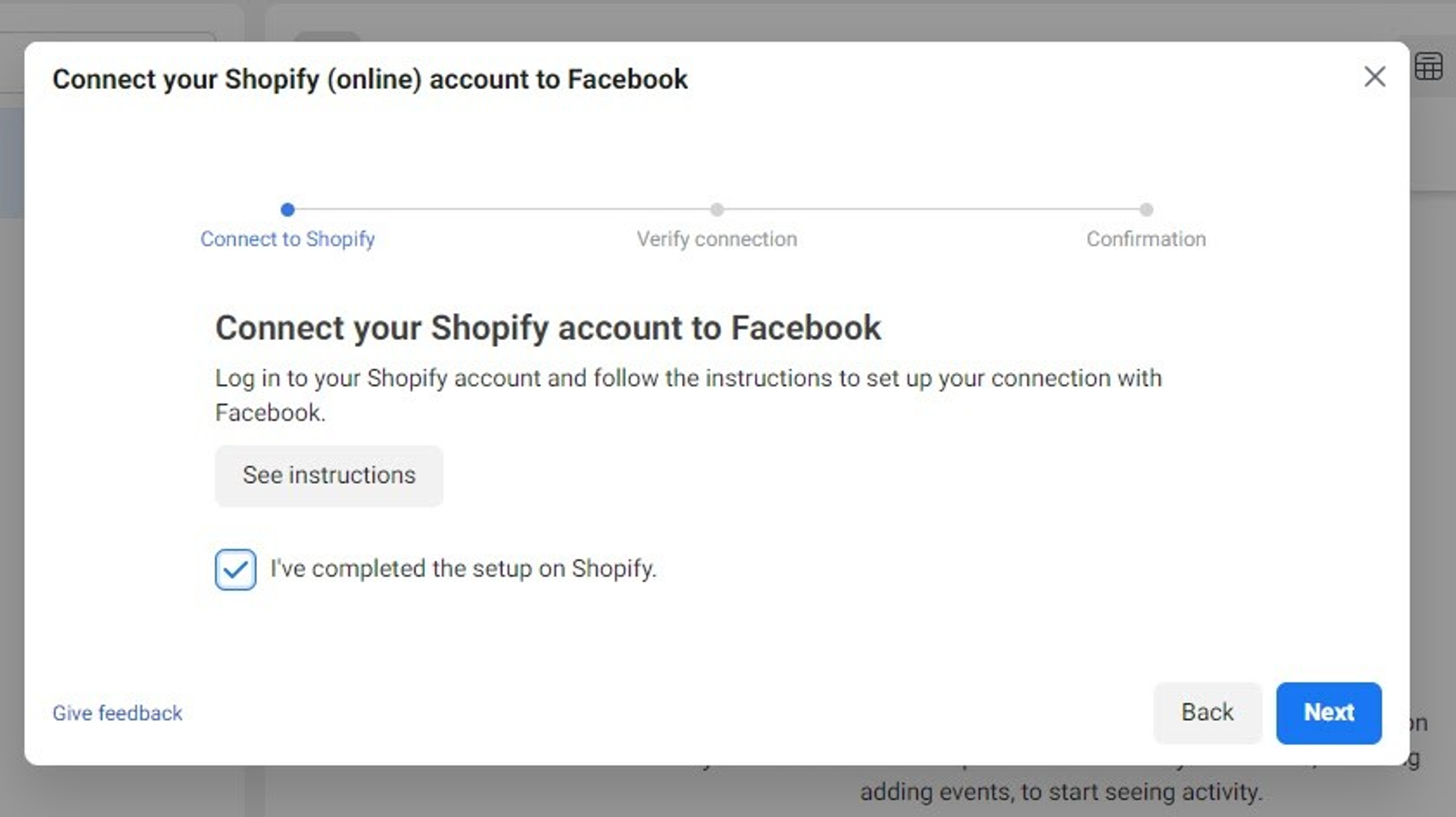
On the next page, paste your website URL in the appropriate space and click "send test traffic." This part of the process tests to see if you have installed your Pixel correctly and if it is functioning the way it should. After this, follow the remaining instructions to complete your Pixel setup.
Creating An Audience
Now that your Pixel is ready, the next part of setting things up is giving Facebook an audience to retarget.
Unlike the typical custom audience for ads, you can narrow down with more metrics than just demography. After adding their ages, gender, and location, you can get more specific by grouping them based on actions. This helps with targeting your audience based on their stage in the sales funnel.
On your page, this would translate to an action that the website visitor takes. Maybe they visited your website but didn't download your app, or they added a product to the cart but did not check out.
So how do you add your audience?
Sign in to your Facebook ad account and click the ads manager on the toolbar by the left side.

Click "Create a Custom Audience."
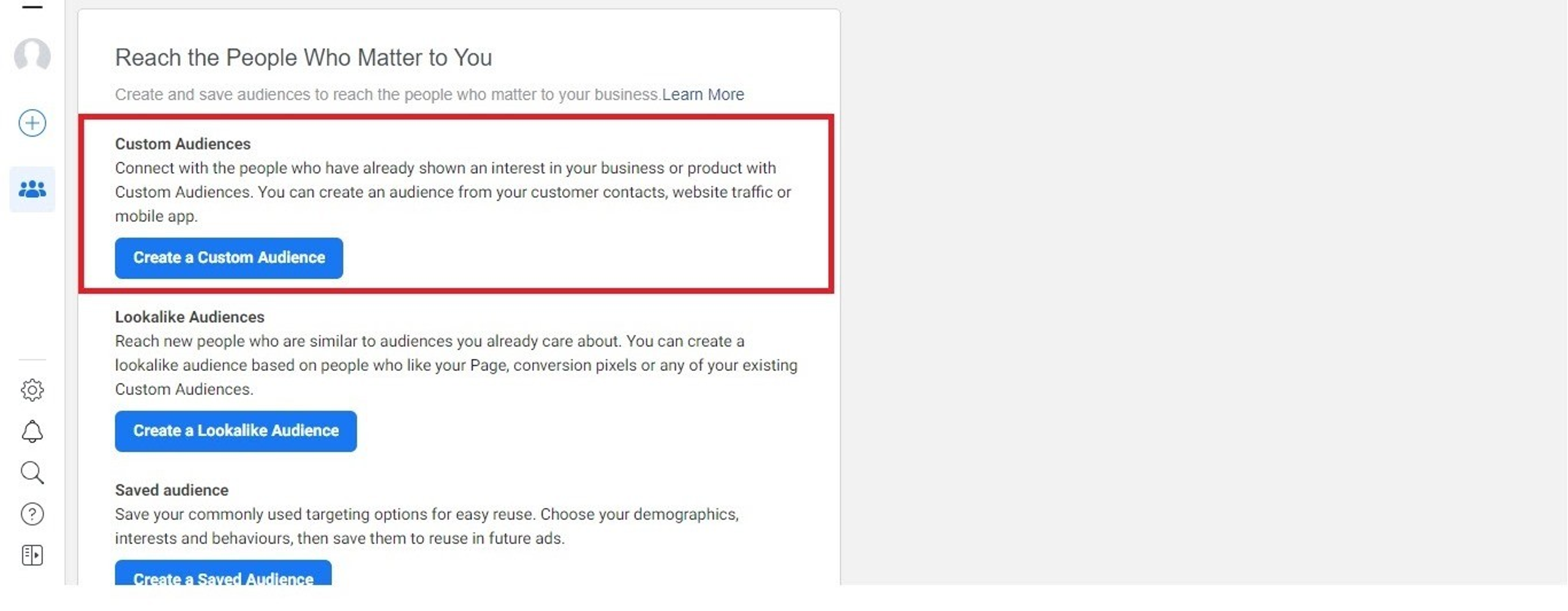
On the next page, select the traffic source you would like to track. The traffic source refers to the audience that you plan to retarget and the medium through which they have interacted previously. Pixel then tracks their activity on this medium and sends it to Facebook so it creates ads that retarget them better.
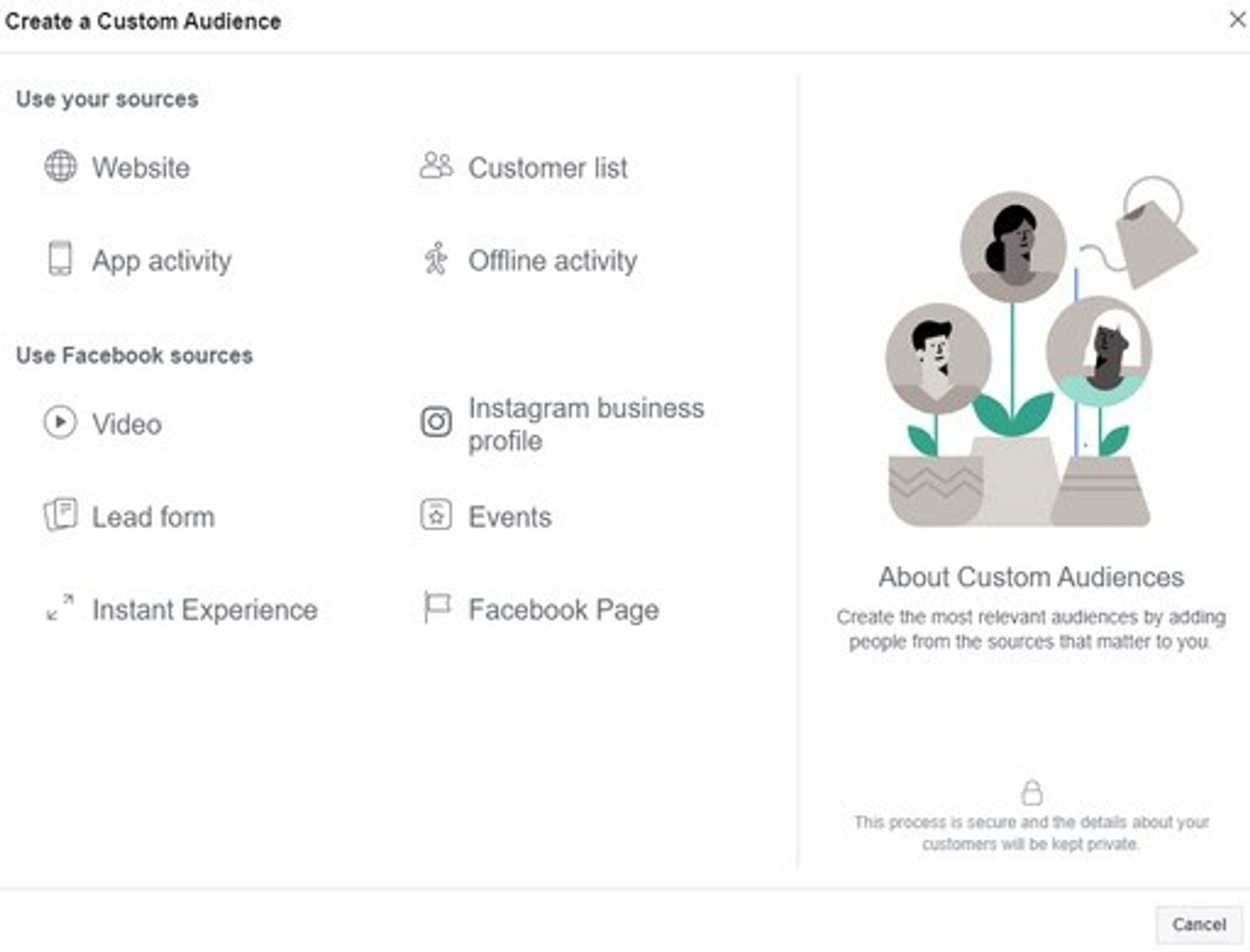
Before you make a choice, let me help you understand what each traffic source is about and how to use it.
Website
This helps you target the people who have engaged with your website in a certain way.
For example, you could retarget those who have viewed a particular product on your website in the last thirty days.
App Activity
If you work with an app, you can target people that have made certain actions like downloading your app. Since you are working with the app, you would need to add the Facebook SDK to your app.
Catalogs
Use your product catalog to create an audience based on which of your products they have interacted with.
Customer List
The customer list is quite similar to list-based targeting. This works by creating a list of customers that have interacted with your business. This can either be a .txt or CDV file depending on where you have saved it. CRM services may also make things easier since they have your customer information integrated.
Offline Activity
Offline activity can also be included under the customer list method. It captures in-store visits, telephone calls, and other activities that have taken place offline.
Meta Sources
This allows you to target audiences based on certain activities they have engaged in across Meta platforms such as Facebook and Instagram, or how they have interacted with ads by Meta.
Picking an Ad Objective
This is the most important part of creating your ad. This is where you state the end goal of your Facebook ad Campaign.
All Facebook ad objectives fall under three major categories. They are awareness, consideration, and conversion.
If you are not trying to reach a new audience, awareness may not be the best objective for your ad campaign.
Since you are trying to lead people who already know you back to your website so you can get more conversions, you can try adding something that would be valuable as a gift. This strategy fits under consideration as an objective.
If you are trying to target customers who started a purchase but abandoned it somewhere before making payments, you will work with a different objective, which is to get these people to convert. A better option for such people would be a good discount offer or a time-bound promo on sales.
Make sure to complete this phase because Facebook uses this part of your setup to determine which ads go to who.
Choosing Your Audience
This may look like a process you've passed through before, but it's not. This is the part where you choose the target audience for this particular retargeting ad.
If your audience size isn’t large enough to run a Facebook Ad, go back to the menu in "Custom Audience" and expand the time frame you have set as a prerequisite.
When you expand it, Facebook keeps an eye on the audience to see how well they respond to your ads and automatically tweaks things for the better where necessary.
Choosing Your Ad Placement
We have done the who and the why, and this brings us to the where. Your ad placement refers to the platforms where your ad would be displayed. Facebook can automatically place your ads on platforms where it thinks best for maximizing your budget. Alternatively, you can go through the options and make your choices, be it Facebook feeds, Instagram stories, Facebook Messenger, or search results.
If you want Facebook to save you the headache of picking your placement, select "Automatic Placement". You can trust it to place your ads where they would most likely achieve the best conversions.
Setting A Budget
You can either set a daily budget for how much you want to spend daily, or a lifetime budget for how much you want to spend throughout the duration of the campaign.
The size of your budget should depend on the size of your business and how familiar you are with Facebook retargeting ads. If you are just starting out, it's advisable to start with a small budget even if you can afford more. This gives you the time to understand your retargeting campaigns without losing too much in the process. When you finally learn what works best, you can adjust your budget based on your findings.
Tracking Your Ad Campaign
Now that your campaign is out there, you don't just stand by and watch it go. It is important to track the progress of your ads using analytical tools. Facebook Pixel serves the purpose effectively. It not only supplies data from your website to Facebook, but also tracks and measures the performance of your campaign in real-time.
Practical Tips for Getting Outstanding Results With Facebook Retargeting Ads
For every basic process, there are advanced strategies for getting outstanding results. I've put a few tips together to help you get the best out of your retargeting ads. Let's dig in.
Segment Your Custom Audiences
When your products cater to a wide range of people, it's best to segment your custom audience. For a store that deals in male accessories, you can tell that their preferences will differ based on their age and experiences. To ensure that your ad is specific and relevant enough, make sure your narrow it to the most specific minimum.
Audience Exclusion:
As much as you want to tell Facebook to retarget those that do this and do that, you also want to tell Facebook to stay away from people who do this and that. For instance, you run a jewelry store and you are running a campaign for a new product. You want to include men, but exclude those who are older than sixty because it is not likely to be their style. When you exclude certain audiences, Facebook can look for more people within the same budget. This makes it an effective way to maximize your budget.
Learn to deal with iOS 14.5
iOS 14.5 allows its users to opt out of data tracking. This means you can't have access to their activities. And when you can't tell what they like, you can't tell what they want. But iOS has a significant share of the Facebook market, so what to do?
Use your Meta sources to create custom audiences.
Set your ads to retarget all visitors to your website rather than visitors to specific landing pages.
Create your customer list using emails and subscribers.
Focus on Awareness and Consideration rather than the conversion objective.
There are several other tips you could leverage, such as running discounts, showing customers products they loved without purchasing them, retargeting people at their Add to Cart stages, and ensuring that you have at least one campaign live at all times.
Facebook retargeting has many benefits in store for your business. Like every other investment, time plays a huge role in determining your ROI so the earlier you kick off, the better!
